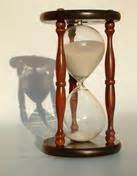You may remember that a few months ago I wrote about the Steve Martin version of ‘Cheaper By The Dozen’. Specifically, the improbable premise that Bonnie Hunt’s book was published and on-the-shelf ready within 6 weeks of her first submission. Without her knowing about it.
I’ve noticed that there are other ‘lies’ being presented to us via television and movies regarding time. Like the time it takes to be accepted to a good college. The time it takes to get results for DNA or fingerprint tests. The time it takes for a legal case to be resolved. How long it actually takes police, fire, and/or ambulance crews to arrive on the scene.
We are a society that revels in speed. We have fast food restaurants, because suddenly we can’t spare  the time it takes to cook a burger from scratch. Car advertisements brag that their vehicle will go from zero-to-60 in so many seconds, and have top speeds of well over 100 mph. (Why do we need that? To get away from those cops that don’t really show up that quickly anyway? And in what universe will we legally be able to use that top speed shown on the speedometer?)
the time it takes to cook a burger from scratch. Car advertisements brag that their vehicle will go from zero-to-60 in so many seconds, and have top speeds of well over 100 mph. (Why do we need that? To get away from those cops that don’t really show up that quickly anyway? And in what universe will we legally be able to use that top speed shown on the speedometer?)
We pay extra for overnight delivery, because we can’t wait more than 24 hours to have that new gadget in our hands. Speaking of deliveries, we don’t even want to wait for the birth to find out the sex of the new baby!
The bottom line is We Want it NOW!
So, as writers, how do we balance portraying our stories realistically and keeping our audience’s attention? If we present a timeline like those on television, there will be those who know the truth and we will be ‘outed’. If we slow it down and give information detail by detail, as it is discovered in real life, we lose the audience. They get bored.
Quite a conundrum, isn’t it? So we show years passing by indicating seasons or particular holidays. Birthday parties are referenced to show a child growing up (first, fifth, 16th, etc…). If we are writing about things from the past to the present, we use radio and television broadcasts, with news highlights, musical cues, or fashion trends to hint that time progresses.
We indicate time going by in minute ways. A girl leaves the doctor’s office amidst a swirl of autumn leaves, having just found out she is expecting. The next scene has her carefully holding on to a railing as she slides along an icy sidewalk, tummy bulging. Then the next scene has her stepping on the daffodils in her hurry to get into the car on the way to the hospital. There – you have 8-1/2 months and three seasons in three scenes (Don’t all you mothers wish it was that easy?). The secret is to skip the boring parts, but leave it cohesive.
Still – mistakes can be made. Like Bonnie Hunt opening her door and having a copy of her complete, printed book thrust into her hands. Ummm….no. So tread carefully when dealing with time. Make your story just realistic enough that the reader can identify with it (like waiting for the birth of that baby)…but not get bored. Anticipation is one thing. Killing time is another.







Very thought provoking…I think this is one of my biggest problems when writing short stories.
Great post! I often think about our Instant Society. We’re impatient. Maybe because we’re spoiled and often self-centered. I liked your thoughts on how to show the passage of time without being boring.